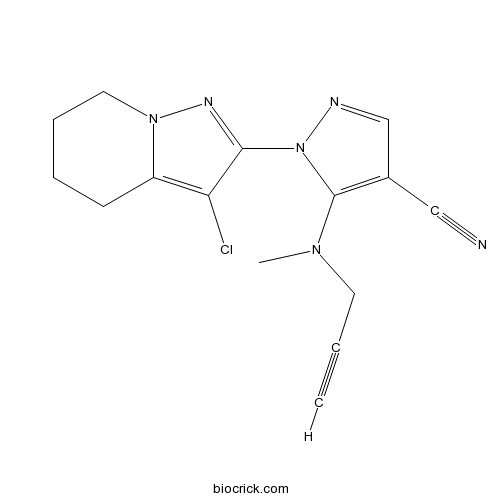PyraclonilCAS# 158353-15-2 |

- BS-181
Catalog No.:BCC1439
CAS No.:1092443-52-1
- CDK inhibitor II
Catalog No.:BCC1464
CAS No.:1269815-17-9
- CGP60474
Catalog No.:BCC1474
CAS No.:164658-13-3
- SNS-032 (BMS-387032)
Catalog No.:BCC1152
CAS No.:345627-80-7
- Dinaciclib (SCH727965)
Catalog No.:BCC3765
CAS No.:779353-01-4
- AT7519
Catalog No.:BCC2541
CAS No.:844442-38-2
Quality Control & MSDS
3D structure
Package In Stock
Number of papers citing our products

| Cas No. | 158353-15-2 | SDF | Download SDF |
| PubChem ID | 11563984 | Appearance | Powder |
| Formula | C15H15ClN6 | M.Wt | 314.77 |
| Type of Compound | N/A | Storage | Desiccate at -20°C |
| Solubility | DMSO : ≥ 30 mg/mL (95.31 mM) *"≥" means soluble, but saturation unknown. | ||
| Chemical Name | 1-(3-chloro-4,5,6,7-tetrahydropyrazolo[1,5-a]pyridin-2-yl)-5-[methyl(prop-2-ynyl)amino]pyrazole-4-carbonitrile | ||
| SMILES | CN(CC#C)C1=C(C=NN1C2=NN3CCCCC3=C2Cl)C#N | ||
| Standard InChIKey | IHHMUBRVTJMLQO-UHFFFAOYSA-N | ||
| Standard InChI | InChI=1S/C15H15ClN6/c1-3-7-20(2)15-11(9-17)10-18-22(15)14-13(16)12-6-4-5-8-21(12)19-14/h1,10H,4-8H2,2H3 | ||
| General tips | For obtaining a higher solubility , please warm the tube at 37 ℃ and shake it in the ultrasonic bath for a while.Stock solution can be stored below -20℃ for several months. We recommend that you prepare and use the solution on the same day. However, if the test schedule requires, the stock solutions can be prepared in advance, and the stock solution must be sealed and stored below -20℃. In general, the stock solution can be kept for several months. Before use, we recommend that you leave the vial at room temperature for at least an hour before opening it. |
||
| About Packaging | 1. The packaging of the product may be reversed during transportation, cause the high purity compounds to adhere to the neck or cap of the vial.Take the vail out of its packaging and shake gently until the compounds fall to the bottom of the vial. 2. For liquid products, please centrifuge at 500xg to gather the liquid to the bottom of the vial. 3. Try to avoid loss or contamination during the experiment. |
||
| Shipping Condition | Packaging according to customer requirements(5mg, 10mg, 20mg and more). Ship via FedEx, DHL, UPS, EMS or other couriers with RT, or blue ice upon request. | ||
| Description | Pyraclonil is a herbicide agent. |

Pyraclonil Dilution Calculator

Pyraclonil Molarity Calculator
| 1 mg | 5 mg | 10 mg | 20 mg | 25 mg | |
| 1 mM | 3.1769 mL | 15.8846 mL | 31.7692 mL | 63.5385 mL | 79.4231 mL |
| 5 mM | 0.6354 mL | 3.1769 mL | 6.3538 mL | 12.7077 mL | 15.8846 mL |
| 10 mM | 0.3177 mL | 1.5885 mL | 3.1769 mL | 6.3538 mL | 7.9423 mL |
| 50 mM | 0.0635 mL | 0.3177 mL | 0.6354 mL | 1.2708 mL | 1.5885 mL |
| 100 mM | 0.0318 mL | 0.1588 mL | 0.3177 mL | 0.6354 mL | 0.7942 mL |
| * Note: If you are in the process of experiment, it's necessary to make the dilution ratios of the samples. The dilution data above is only for reference. Normally, it's can get a better solubility within lower of Concentrations. | |||||

Calcutta University

University of Minnesota

University of Maryland School of Medicine

University of Illinois at Chicago

The Ohio State University

University of Zurich

Harvard University

Colorado State University

Auburn University

Yale University

Worcester Polytechnic Institute

Washington State University

Stanford University

University of Leipzig

Universidade da Beira Interior

The Institute of Cancer Research

Heidelberg University

University of Amsterdam

University of Auckland

TsingHua University

The University of Michigan

Miami University

DRURY University

Jilin University

Fudan University

Wuhan University

Sun Yat-sen University

Universite de Paris

Deemed University

Auckland University

The University of Tokyo

Korea University
Pyraclonil is a herbicide agent.
- Methyl 3-(4-methoxyphenyl)propanoate
Catalog No.:BCN4051
CAS No.:15823-04-8
- Naringenin-7-O-glucuronide
Catalog No.:BCC8215
CAS No.:158196-34-0
- Fmoc-Ser(HPO3Bzl)-OH
Catalog No.:BCC3543
CAS No.:158171-14-3
- 21-O-Tigloylgymnemagenin
Catalog No.:BCN7854
CAS No.:1581276-63-2
- 5-Hydroxy-6,7,8-trimethoxycoumarin
Catalog No.:BCN7470
CAS No.:1581248-32-9
- para-iodoHoechst 33258
Catalog No.:BCC1838
CAS No.:158013-43-5
- meta-iodoHoechst 33258
Catalog No.:BCC1739
CAS No.:158013-42-4
- ortho-iodoHoechst 33258
Catalog No.:BCC1824
CAS No.:158013-41-3
- Chitinase-IN-2
Catalog No.:BCC5534
CAS No.:1579991-63-1
- Chitinase-IN-1
Catalog No.:BCC5533
CAS No.:1579991-61-9
- (Z)-2-decenoic acid
Catalog No.:BCC1295
CAS No.:15790-91-7
- 5-Benzimidazolecarboxylic acid
Catalog No.:BCC8739
CAS No.:15788-16-6
- Demethyl calyciphylline A
Catalog No.:BCN7040
CAS No.:1584236-34-9
- PSI
Catalog No.:BCC1124
CAS No.:158442-41-2
- BMS-983970
Catalog No.:BCC5509
CAS No.:1584713-87-0
- ω-Agatoxin TK
Catalog No.:BCC7489
CAS No.:158484-42-5
- Catalpalactone
Catalog No.:BCN1708
CAS No.:1585-68-8
- Cnidioside B methyl ester
Catalog No.:BCN1707
CAS No.:158500-59-5
- Eclalbasaponin I
Catalog No.:BCN8244
CAS No.:158511-59-2
- Ombuin 3-glucoside
Catalog No.:BCN4055
CAS No.:158642-42-3
- Rimonabant hydrochloride
Catalog No.:BCC1898
CAS No.:158681-13-1
- Dihydrexidine hydrochloride
Catalog No.:BCC5681
CAS No.:158704-02-0
- 2-Naphthyl N-benzoylphenylalaninate
Catalog No.:BCC8583
CAS No.:15873-25-3
- Aescin IIA
Catalog No.:BCN6551
CAS No.:158732-55-9
Herbicide discharge from rice paddy fields by surface runoff and percolation flow: A case study in paddy fields in the Lake Biwa basin, Japan.[Pubmed:30363114]
J Pestic Sci. 2018 Feb 28;43(1):24-32.
The transport of three herbicides, pyriminobac-methyl, imazosulfuron and Pyraclonil from a watershed that includes 40 ha of paddy fields to a drainage canal was monitored in the Lake Biwa basin, Japan. Based on the intensive monitoring of all paddy plots and in the drainage canal conducted on 3 days during and after the application period, the passage of herbicide discharge from the paddy fields to the drainage canal was separated into surface runoff obtained from field observations and percolation flow calculated from the herbicide mass balance. Surface runoff from paddy plots immediately after herbicide application, discharging a large volume of paddy water, or both processes in conjunction had a significant effect on herbicide discharge. Without surface runoff, paddy fields discharged a consistently high amount of herbicide gradually by percolation flow. These results suggest that considerable amounts of herbicides were discharged into the drainage canal through percolation even if appropriate water management to prevent herbicide surface runoff was practiced.


